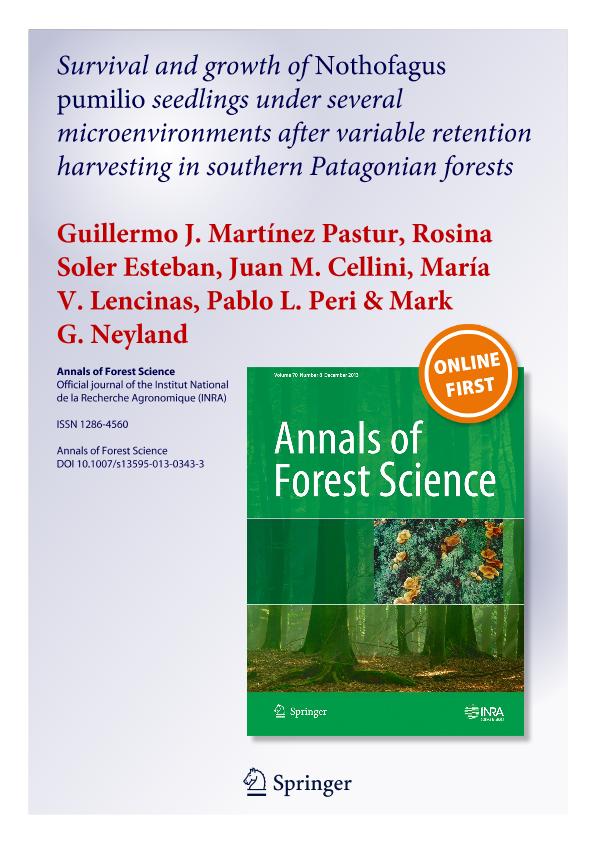Mostrar el registro sencillo del ítem
dc.contributor.author
Martínez Pastur, Guillermo José

dc.contributor.author
Soler Esteban, Rosina Matilde

dc.contributor.author
Cellini, Juan Manuel
dc.contributor.author
Lencinas, María Vanessa

dc.contributor.author
Peri, Pablo Luis

dc.contributor.author
Neyland, Mark G.
dc.date.available
2016-05-03T20:27:40Z
dc.date.issued
2014-01
dc.identifier.citation
Martínez Pastur, Guillermo José; Soler Esteban, Rosina Matilde; Cellini, Juan Manuel; Lencinas, María Vanessa; Peri, Pablo Luis; et al.; Survival and growth of Nothofagus pumilio seedlings under several microenvironments after variable retention harvesting in southern Patagonian forests; Springer; Annals of Forest Science; 71; 3; 1-2014; 349-362
dc.identifier.issn
1286-4560
dc.identifier.uri
http://hdl.handle.net/11336/5496
dc.description.abstract
Context
Variable retention prescriptions for Nothofagus pumilio forests provide for biodiversity conservation and natural regeneration by controlled opening of the canopy. Harvesting generates different microenvironments which present dissimilar conditions for seedling establishment, due to positive or negative influences over biotic and abiotic factors.
Aims
This study evaluated seedling survival and performance in different microenvironments within the harvested stands. Tested hypotheses stated that seedling stress and performance were influenced by harvesting due to changes in forest structure, microclimate, soil properties, and nutrient availability.
Methods
In the stands harvested by variable retention, five contrasting microenvironments were selected as treatments for the experiments and sampling. Environmental variables were related to ecophysiological, seedling survival, and performance.
Results
The modification of forest structure (crown cover and tree density) and the presence of coarse woody debris greatly affect the effective rainfall and global radiation reaching understorey level, influencing seedling stress and consequently survival and performance. Harvesting also modifies soil properties (e.g., soil bulk density) and coarse woody debris accumulation which in turn influences soil moisture and/or solar radiation levels. Analyses showed that seedlings received benefits of microenvironment variation after harvesting. Areas covered with middle or fine woody debris presented regeneration with better ecophysiological response and seedling performance, although dispersed retention areas (far away from remnant trees) and roads could also present suitable conditions for seedling survival and performance.
Conclusions
The proportion of different microenvironments in the harvested forests will determine the amount of natural recruitment of regeneration and consequently the success of proposed silvicultural management. Forest practices must be manipulated to increase the proportion of favorable microenvironments (e.g., woody debris), allowing greater natural regeneration success during the first years after harvesting.
dc.format
application/pdf
dc.language.iso
eng
dc.publisher
Springer

dc.rights
info:eu-repo/semantics/openAccess
dc.rights.uri
https://creativecommons.org/licenses/by-nc-sa/2.5/ar/
dc.subject
Aggregated Retention
dc.subject
Dispersed Retention
dc.subject
Microenvironments
dc.subject
Ligth Availability
dc.subject
Soil Moisture
dc.subject
Soil Properties
dc.subject.classification
Silvicultura

dc.subject.classification
Agricultura, Silvicultura y Pesca

dc.subject.classification
CIENCIAS AGRÍCOLAS

dc.title
Survival and growth of Nothofagus pumilio seedlings under several microenvironments after variable retention harvesting in southern Patagonian forests
dc.type
info:eu-repo/semantics/article
dc.type
info:ar-repo/semantics/artículo
dc.type
info:eu-repo/semantics/publishedVersion
dc.date.updated
2016-05-06 15:52:43.262787-03
dc.journal.volume
71
dc.journal.number
3
dc.journal.pagination
349-362
dc.journal.pais
Francia

dc.journal.ciudad
Paris
dc.description.fil
Fil: Martínez Pastur, Guillermo José. Consejo Nacional de Investigaciones Científicas y Técnicas. Centro Austral de Investigaciones Científicas; Argentina
dc.description.fil
Fil: Soler Esteban, Rosina Matilde. Consejo Nacional de Investigaciones Científicas y Técnicas. Centro Austral de Investigaciones Científicas; Argentina
dc.description.fil
Fil: Cellini, Juan Manuel. Universidad Nacional de la Plata. Facultad de Ciencias Naturales y Museo. Laboratorio de Investigacion en Sistemas Ecologicos y Ambientales; Argentina
dc.description.fil
Fil: Lencinas, María Vanessa. Consejo Nacional de Investigaciones Científicas y Técnicas. Centro Austral de Investigaciones Científicas; Argentina
dc.description.fil
Fil: Peri, Pablo Luis. Instituto Nacional de Tecnología Agropecuaria; Argentina. Universidad Nacional de la Patagonia Austral; Argentina. Consejo Nacional de Investigaciones Científicas y Técnicas; Argentina
dc.description.fil
Fil: Neyland, Mark G.. Forestry Tasmania; Australia
dc.journal.title
Annals of Forest Science

dc.relation.alternativeid
info:eu-repo/semantics/altIdentifier/url/http://link.springer.com/article/10.1007%2Fs13595-013-0343-3
dc.relation.alternativeid
info:eu-repo/semantics/altIdentifier/doi/10.1007/s13595-013-0343-3
dc.relation.alternativeid
info:eu-repo/semantics/altIdentifier/doi/http://dx.doi.org/10.1007/s13595-013-0343-3
Archivos asociados
